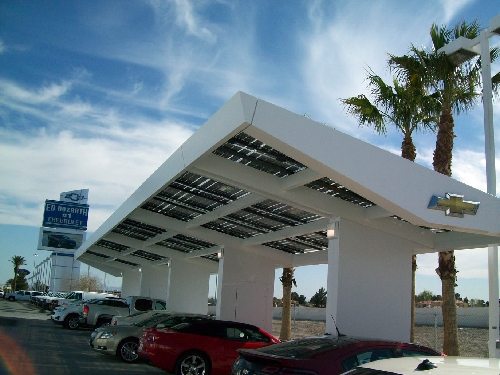Solar power, plug-in cars mesh well
Synergy is defined as the interaction of elements that, when combined, produce a greater effect than the sum of the individual elements.
Real examples of synergy were revealed by the National Electrical Contractors Association during its annual convention and expo at Mandalay Bay in Las Vegas last week. Electrical contracting companies from around the country gathered to share the latest developments about all things electric and also explore new potential markets for their companies and workers.
At this year's convention, the Electrical Joint Apprenticeship Training Committee of Southern Nevada showcased some of the educational programs it has been promoting to local electricians. These have included instruction on renewable solar and wind turbine electrical generation technologies and electric vehicle supply equipment technologies for plug-in electric cars. Findlay Chevrolet provided a Chevrolet Volt as the booth display's centerpiece.
During an electrician apprenticeship training program, classroom education is coupled with paid on-the-job training supervised by an experienced journeyman electrician. This ensures the capability of the installer while the apprentice gains practical experience solving real-world problems.
Here in Southern Nevada, where the sun shines 300 days a year, there is a synergy that benefits people who install photovoltaic solar panels on the roofs of their homes and buy plug-in electric cars. Unlike other homeowners, they can create a portion of the energy that powers the appliances in their homes and provides fuel for a plug-in electric car.
This combination of photovoltaic solar cell arrays and electric vehicle supply equipment is already in use and available free to the general public within three Las Vegas government facilities: the Clark County Government Center parking lot, Las Vegas City Hall's parking garage and the Stupak Community Center. For Chevy Volt owners, Ed Bozarth Chevrolet in northwest Las Vegas uses a photovoltaic solar canopy with six charging stations that can recharge the dealership's inventory of Chevrolet Volts and provide free electrons to visiting customers.
The cost of photovoltaic panels has dropped dramatically during the past two years because of increasing competition from China. Although this trend has been painful for American companies that have gone out of business, like Amonix in North Las Vegas, there has been a tremendous decrease in the cost of solar cells to consumers; those costs now stand at about 84 cents a watt.
A home photovoltaic solar cell array installation that also includes peripheral hardware materials, electric power conditioning equipment and labor costs is now about $4 per watt. This price is a full dollar less than just a year ago and $2 less than two years ago.
A 2.5-kilowatt photovoltaic solar cell array, mounted on a south-facing rooftop in Southern Nevada, can generate about 4,000 kilowatt-hours each year, studies by NV Energy show. If the energy generated by this photovoltaic solar cell array was grid-tied, it could be stored on the public utility grid and purchased by the utility. The homeowner would get a credit on his monthly NV Energy bill.
The cost of this solar array at $4 per watt would be $10,000. Deduct a federal tax credit of 30 percent and the homeowner's net cost is $7,000.
A plug-in electric car can travel about 3 to 4 miles per kilowatt-hour. Refueling from a home rooftop power system that generates 4,000 kilowatt-hours per year would enable an electric car to travel about 12,000 miles every year on converted sunlight.
For the homeowner, there also is a federal tax credit as much as $7,500 for plug-in electric cars, depending on the size of the battery pack. If a homeowner's average annual gasoline transportation costs before purchasing an electric car were about $1,500 per year, the photovoltaic solar array could pay back installation costs in less than five years, and continue to provide free electric car fuel for another 20 to 25 years, the typical lifetime of the photovoltaic solar cell array.
Peter Diamandis, CEO of the X Prize Foundation, delivered a keynote address to conference attendees during the convention's final day. His recent book "Abundance: The Future is Better Than You Think" alluded to technological synergies. During 2004, the first Ansari X Prize of $10 million was awarded to Mojave Aerospace Ventures. The team's rocket plane, SpaceShipOne, was launched twice within one week from its mothership, White Knight, while suspended in midair. During each flight, SpaceShipOne was piloted 64 miles into suborbital outer space before returning home to its spaceport in Mojave, Calif.
The interaction of elements, when combined, produce a greater effect than the sum of the parts. Synergy!
Stan Hanel has worked in the electronics industry for more than 30 years and is a long-time member of the Electric Auto Association and the Las Vegas Electric Vehicle Association. Hanel writes and edits for EAA's "Current Events" and LVEVA's "Watts Happening" newsletters. Contact him at stanhanel@aol.com.














